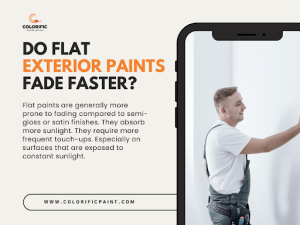Any homeowner or property manager must make a critical choice about the exterior paint they use. It changes not only how your property looks, but also how long it lasts and how well it handles the weather.
Selecting exterior paints can be daunting given the wide range of choices on the market. This article will enable you to negotiate several elements and considerations so you may maximize your purchase of exterior paint.
Why Exterior Paint Matters
Exterior paint serves both functional and aesthetic purposes. It protects your home from the elements like rain, sun, wind, and moisture while also contributing to curb appeal.
The right exterior paint can provide an additional layer of protection against UV rays, mildew, and peeling, thereby increasing the lifespan of your exterior surfaces.
Understanding the Importance of Durability
The durability of exterior paint depends on the type and quality of paint you choose. A good-quality paint will last longer and require less frequent touch-ups or repainting, saving you time and money in the long run.
Choosing Exterior Paints
One of the most important steps in making the most of your exterior paint purchase is selecting the right type of paint. Not all exterior paints are created equal, and each has its pros and cons.
Types of Exterior Paints
Acrylic Paint
This type is known for its durability and flexibility. It can withstand harsh weather conditions and is less prone to cracking.
Latex Paint
Another durable option, latex paints are easy to apply and clean, making them a favorite among homeowners.
Oil-Based Paint
Oil-based paints provide a smoother finish and are excellent for covering tough surfaces like metal and wood, though they can take longer to dry.
Consider Your Climate
Before you make a purchase, consider the weather conditions in your area. For example, homes in regions with heavy rainfall may benefit from mildew-resistant paints, while homes in sunny areas should prioritize UV-resistant coatings.
Buy Exterior Paints: What to Look For
When you’re ready to buy exterior paints, you must consider more than just the color. Quality, performance, and finish are just as important.
The Role of VOC Levels
Low or no-VOC (volatile organic compounds) paints are safer for the environment and the health of your family. Many manufacturers now offer high-performance exterior paints with low VOC content without compromising quality.
Can Exterior Paints Be Mixed?
One common question is whether exterior paints can be mixed to achieve custom colors or finishes. The answer is yes, but with caution. Mixing paints of different bases (like oil and water) 2or brands can affect the paint’s durability and finish. Always test a small sample before applying the mixed paint to the entire surface.
Comparison of Exterior Paints: Key Features to Consider
Comparing exterior paints before making a purchase can help you choose the best option for your specific needs.
Color Selection
Different brands offer varying shades and color palettes. While choosing a color that suits your aesthetic is important, it’s also crucial to ensure the paint offers protection and longevity.
Finish Options
Flat Finish
Best for older homes or surfaces with imperfections as it hides flaws well, but it may fade faster than other finishes.
Satin or Eggshell
Provides a slight gloss and works well on most surfaces. It’s easier to clean than a flat finish.
Gloss or Semi-Gloss
Offers a shiny, reflective surface that’s easy to clean, but it will highlight imperfections more than a satin or flat finish.
Do Dark Exterior Paints Fade Faster?
Yes, dark exterior paints tend to fade faster than lighter shades. This is due to their higher absorption of UV rays, which breaks down the paint pigments over time. If you’re set on a darker color, look for paints with UV-resistant properties to help prolong the color’s life.
Can You Make Exterior Paints a Lighter Shade?
Yes, you can make exterior paints lighter by mixing in white paint. However, be careful when doing so. Adding too much white paint may affect the paint’s finish or consistency. It’s recommended to consult with a paint specialist or manufacturer for guidance on the ratio and any potential effects on the durability of the paint.
Do Flat Exterior Paints Fade Faster?
Flat paints are generally more prone to fading compared to semi-gloss or satin finishes. They absorb more sunlight, which accelerates color degradation. While flat paints hide imperfections, they require more frequent touch-ups. If you’re looking for longevity, consider opting for a satin or semi-gloss finish, especially on surfaces that are exposed to constant sunlight.
How to Compare Exterior Paints?
When comparing exterior paints, balance performance with price. Some high-end paints come with additional features like anti-fungal properties, UV resistance, and longer warranties.
Cost per Gallon vs. Cost per Year
While cheaper paints might seem more budget-friendly upfront, they often require more frequent repainting. Calculate the cost over several years to determine which paint offers the best long-term value.
Coverage
Check the coverage rating on the paint can. Higher-quality paints often offer better coverage, meaning you’ll need fewer coats, which saves time and money.
Expert Tips to Make the Most of Your Exterior Paint Purchase
To make sure you get the best value from your exterior paint purchase, follow these expert tips:
Buy a Sample and Test First
Before committing to a large purchase, buy a small sample of the paint and test it on a section of your home’s exterior. This will give you a better idea of how the color looks in different lighting conditions and how the paint reacts to the surface.
Prep the Surface
Preparation is key to a long-lasting paint job. Ensure the surface is clean, dry, and free of cracks or peeling paint before applying the new paint. Properly prepped surfaces help the paint adhere better and last longer.
Prime Before Painting
If the existing paint is severely worn or you’re painting a drastically different color, consider applying a primer before the paint. This ensures better coverage and enhances the durability of the final coat.
Conclusion
Buying exterior paint is an investment in your home’s appearance and protection. By considering factors like durability, climate, color, and finish, you can make an informed decision that enhances your home’s curb appeal while ensuring long-lasting performance.
Compare exterior paints carefully, and don’t forget to test samples before committing to a full purchase. With the right preparation and choices, your exterior paint can last for years to come.
Read More:
The Ultimate Guide to Interior Paint Types
Trending Interior Paints Colors and Combinations
Commercial Painting Supplies: Essential Tools You Need for Successful Projects
Residential Painting Services: A Homeowner’s Guide to Professional Results

